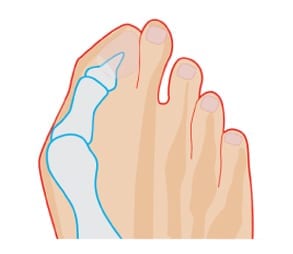Bunions
Bunions
A bunion is a bony lump on the side of your foot, which develops when your big toe starts to angle towards your second toe. The bunion eventually causes discomfort and pain. The skin over the lump can become red, blistered or infected. A fluid-filled space called a bursa may also develop under your skin in this area and this can be painful if it becomes inflamed. This is called bursitis. You can also get a bunion deformity concerning your little toe this is often called a “tailor’s bunion”. Bunions are typically progressive and usually get worse over time. Symptoms include pain, stiffness, redness, difficulty walking and difficulty wearing shoes.
 A bunion occurs as a result of a problem with your big toe known as hallux valgus. Hallux means the big toe and valgus means that it’s pointing outwards towards the other toes. In hallux valgus the bone in your foot at the base of your big toe, called the first metatarsal, moves out at the side of your foot. Your big toe angles towards your other toes. There is evidence that people can inherit a tendency to develop bunions. However, it doesn’t always follow that if your parents or grandparents have bunions, you will have them too.
A bunion occurs as a result of a problem with your big toe known as hallux valgus. Hallux means the big toe and valgus means that it’s pointing outwards towards the other toes. In hallux valgus the bone in your foot at the base of your big toe, called the first metatarsal, moves out at the side of your foot. Your big toe angles towards your other toes. There is evidence that people can inherit a tendency to develop bunions. However, it doesn’t always follow that if your parents or grandparents have bunions, you will have them too.
A good understanding of foot biomechanics is required if you wish to address the cause of the bunion. The anatomy involved can be quite complex and if the forces that are causing the bunion can be reversed it is possible to keep the bunion from worsening. Proper shoe gear and arch control also plays an important role.
The best conservative care will not reverse a bunion. If you have severe pain or discomfort from a bunion, you will typically need to have an operation to correct it. The Doctors at ETFA are podiatrists who are specifically trained to treat the bones and joints in the foot. There are over 130 different operations that can be carried out to treat bunions. Most of these procedures will aim to narrow your foot by straightening out your big toe joint as much as possible. An operation won’t return your foot back to normal, but most people find that surgery reduces their symptoms and improves the shape of their foot. The operation you have will depend on how severe your bunion is and whether or not you have arthritis.
One of the most common operations is called a metatarsal osteotomy. Your surgeon will cut one or more of the bones in your foot and then reset them so they are in line. He or she will also cut away the part of your big toe joint that is sticking out. Your surgeon may also correct the ligaments and tendons inside your foot by making them looser or tighter.
Another simpler operation that you may have is called an exostectomy (also sometimes called bunionectomy). In this procedure, your surgeon shaves off the part of the bone that is sticking out (ie the bunion). However, the bones aren’t straightened out. As this operation doesn’t correct the position of the bones, your bunion is more likely to return.
As with all surgery there are risks associated with these procedures. It’s likely that you will find the condition is much improved, but you may still have some pain and your big toe may feel stiffer. It’s also possible that in time the bunion will develop again.
PLEASE NOTE:
The information contained in this article is not intended to provide advice for individual problems, nor to substitute for professional advice or care from a physician. For answers to specific questions concerning your personal circumstances, you should consult your physician directly.
